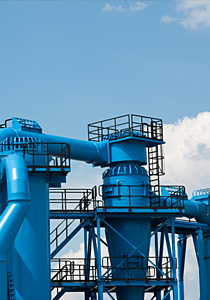Featured Sustainable Manufacturing Case Studies
If you know a case study that should be added to the Clearinghouse or featured on this page, please contact us.The following case studies are examples of manufacturers and other organizations that have successfully implemented sustainable manufacturing practices. These case studies illustrate the benefits that come from proactively addressing sustainability. See the Sustainable Business Clearinghouse for additional case study resources.
- Advanced Composite Structures: Lean Manufacturing
- Using the Value Mapping Process, New Mexico Manufacturing Extension Partnership analyzed and reviewed the production process and the layout of the company’s production area. ACS was able to eliminate excess movement, materials, and tooling to help create a more streamlined product flow. The company reduced costs by 65%, increased production from 20 units per shift to 45 units per shift, reduced its production facility size by 73%, and reduced scrap rates from 24% to 1.8%.
- Besam North America/Assa Abloy: Energy Management
- NC State University Industrial Assessment Center and the NC State Industrial Extension Service’s E3 (Economy, Energy, and Environment) initiative collaborated to provide Besam with targeted energy, waste, and productivity surveys. Besam followed several recommendations from the energy management survey, including replacement of metal halide lighting with fluorescent fixtures with occupancy sensors, installation of high efficiency lamps and electronic ballasts with occupancy sensors, reduction of compressor air pressure, and repair of compressed air leaks. Total annual savings from these efforts was 233,555 kWh/$25,776.
- Bureau of Land Management: Energy Savings Performance Contract
- The U.S. Department of the Interior Bureau of Land Management (BLM) successfully implemented an energy savings performance contract (ESPC) with Johnson Controls, Inc. (JCI) to implement energy efficiency improvements at remote BLM sites. This $3.6 million project covered small BLM facilities across six western states (Colorado, Idaho, Montana, Nevada, Oregon, and Wyoming), which make up half of the states that the BLM covers. In addition to energy savings, BLM achieved the following emissions reductions:
- 3,986,750 pounds per year of CO2
- 6,114 pounds per year of NOx
- 5,321 pounds per year of SO2
- Canyon Creek Cabinet Company: Lean Manufacturing and Pollution Prevention
- Canyon Creek implemented a series of process improvements to reduce hazardous and solid wastes, reduce wastewater discharges, and energy consumption. Production improvements included reduced lead time, defects, and material loss and damage. Total cost savings for the company are approximately $1,189,550 per year, with increased production from about 900 cabinets per day on average to about 1,000 cabinets per day.
- Chrome Deposit Corporation: Energy Efficiency and Responsible Business Practices
- Chrome Deposit Corporation embarked on an effort to increase energy efficiency while simultaneously enhancing its responsible business practices. By adjusting boiler settings and repairing minor gas line leakage the company reduced its natural gas consumption by 12%. The purchase of two chillers and implementation of a closed loop system to cool heated components resulted in an 85% reduction in water use.
- Custom Print: Pollution Prevention
- An examination of the company’s inventory and purchasing records demonstrated over 80 different chemicals on-site. A team of press operators, purchasing staff and maintenance personnel investigated the causes and suggested ways for reducing the chemical inventory. Other suggestions included modifying ventilation to improve worker health and reducing wasted ink. As a result, the company’s chemical inventory was reduced by 70% with estimated saving of $5,000 per year. The company also reduced its air conditioning needs, which cut electricity costs by $2,000/month (40%) and reduced its wasted ink by training employees to mix specialty colors from existing ink stocks.
- Freescale Semiconductor: Energy Efficiency Projects
- Two of Freescale Semiconductor’s major energy-using systems were assessed for energy efficiency. Following the assessment, the company implemented projects which included adjustments to water pumping and compressed air systems. As a result, the company’s Oak Hill Fabrication plant in Austin, Texas reduced its annual energy consumption by 28 million kWh of electricity and 26,000 million Btu of natural gas between 2006 and 2009, with more than $2 million in annual savings.
- Guardian Automotive: Waste Reduction Program
- Guardian Automotive’s Ligonier Plant implemented a waste reduction program to continuously search for ways to reuse and recycle materials. The company now recycles, among other materials, unused glass cullet, fiberglass, and scrap polyvinyl chloride. In 2005, the Ligonier Plant recycled more than 13,000 tons of waste and saved over $360,000.
- Kennecott Utah Copper Refinery: Combined Heat and Power System
- Kennecott Utah improved the energy efficiency of its refinery through installation of combined heat and power system in 2010. The 6-megawatt system produces more than half of the refinery’s total electricity needs and waste heat from the CHP is recycled to produce process steam. The 6 MW of electricity replaces power that purchased from the coal-powered grid, in addition to energy required to make process steam. The system reduces NOx emissions by 90%, SO2 emissions by nearly 99%, and annual CO2 emissions by 36,000 tons.
- Shaw Industries: Energy Assessment and Management
- Shaw Industries saved $872,000 and 93,000 MMBtu in natural gas and No. 6 fuel oil by integrating cost-effective recommendations into its energy management program. The implementation costs added up to about $1.5 million, which paid back in less than two years.
For additional case studies, see the resources in the Sustainable Business Clearinghouse.
